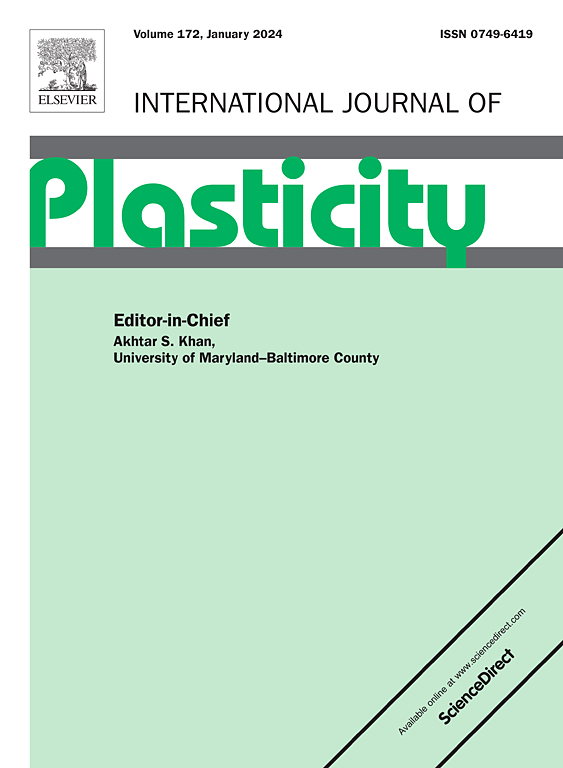Graph neural network unveils the spatiotemporal evolution of structural defects in sheared granular materials
IF 9.4
1区 材料科学
Q1 ENGINEERING, MECHANICAL
引用次数: 0
Abstract
The disordered nature of granular materials poses great difficulty to the accurate characterization of microscopic structures. Despite numerous handcrafted structural indicators, the relationship between particle-scale structure and dynamics, as well as the structural origins of complex constitutive behaviors, remain subjects of debate. In this paper, we utilize a Graph Convolutional Neural Network (GCNN) to establish the structure-property relationship within granular materials. The GCNN model effectively identifies active particles exhibiting intense nonaffine activities based solely on initial particle positions, without relying on handcrafted features. Additionally, we derive a structural indicator called susceptibility from the GCNN output, which quantifies the fragility of local structures to external stimuli and enables the characterization of structural evolution during the shearing process. We demonstrate that structural defects with high susceptibility tend to form spatial clusters, and the distinct failure modes in dense and loose granular assemblies are driven by the differing spatiotemporal evolution of these defect clusters. Our findings suggest that the structural origin of macroscopic yielding in dense granular materials lies in the formation of system-spanning defect clusters, which facilitates the percolation of high-mobility zones and the development of shear bands. Finally, our study indicates that graph-based neural networks are well-suited for modeling and predicting the complex behaviors of granular materials, providing a powerful approach to uncovering underlying mechanisms and deepening our understanding of these materials.
图神经网络揭示剪切颗粒材料结构缺陷的时空演化
颗粒材料的无序性给微观结构的准确表征带来了很大的困难。尽管有许多手工制作的结构指标,粒子尺度结构和动力学之间的关系,以及复杂本构行为的结构起源,仍然是争论的主题。在本文中,我们利用图卷积神经网络(GCNN)来建立颗粒材料内部的结构-性能关系。GCNN模型仅基于初始粒子位置有效地识别具有强烈非仿射活性的活性粒子,而不依赖于手工制作的特征。此外,我们从GCNN输出中导出了一个称为敏感性的结构指标,该指标量化了局部结构对外部刺激的脆弱性,并能够表征剪切过程中的结构演变。研究结果表明,具有高敏感性的结构缺陷往往会形成空间团簇,并且这些缺陷团簇的不同时空演化驱动了致密和松散颗粒组合中不同的失效模式。我们的研究结果表明,致密颗粒材料宏观屈服的结构根源在于系统跨越缺陷团簇的形成,这有利于高迁移带的渗透和剪切带的发展。最后,我们的研究表明,基于图的神经网络非常适合于建模和预测颗粒材料的复杂行为,为揭示潜在机制和加深我们对这些材料的理解提供了强有力的方法。
本文章由计算机程序翻译,如有差异,请以英文原文为准。
求助全文
约1分钟内获得全文
求助全文
来源期刊

International Journal of Plasticity
工程技术-材料科学:综合
CiteScore
15.30
自引率
26.50%
发文量
256
审稿时长
46 days
期刊介绍:
International Journal of Plasticity aims to present original research encompassing all facets of plastic deformation, damage, and fracture behavior in both isotropic and anisotropic solids. This includes exploring the thermodynamics of plasticity and fracture, continuum theory, and macroscopic as well as microscopic phenomena.
Topics of interest span the plastic behavior of single crystals and polycrystalline metals, ceramics, rocks, soils, composites, nanocrystalline and microelectronics materials, shape memory alloys, ferroelectric ceramics, thin films, and polymers. Additionally, the journal covers plasticity aspects of failure and fracture mechanics. Contributions involving significant experimental, numerical, or theoretical advancements that enhance the understanding of the plastic behavior of solids are particularly valued. Papers addressing the modeling of finite nonlinear elastic deformation, bearing similarities to the modeling of plastic deformation, are also welcomed.
 求助内容:
求助内容: 应助结果提醒方式:
应助结果提醒方式:


